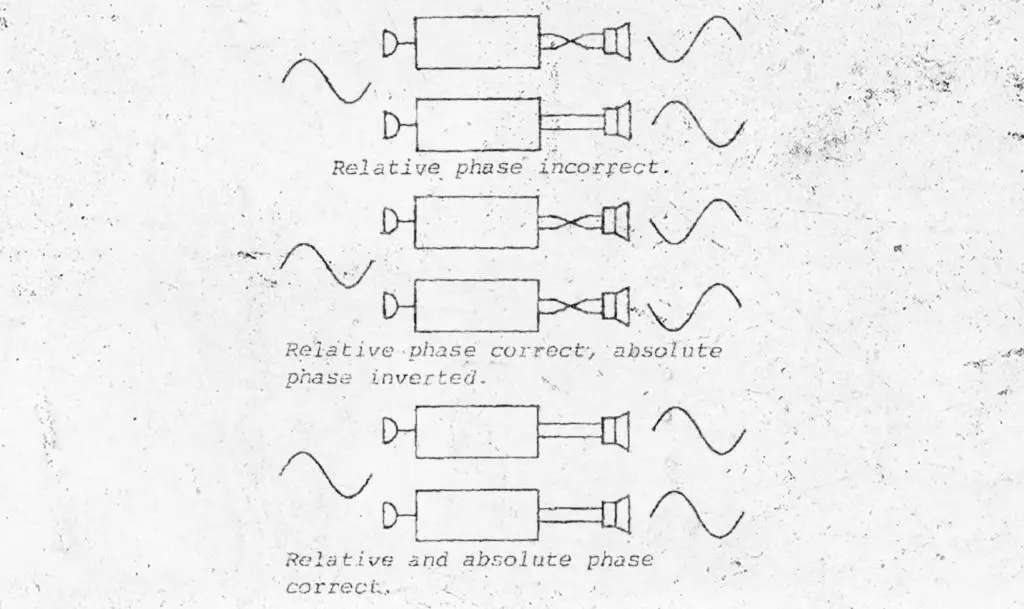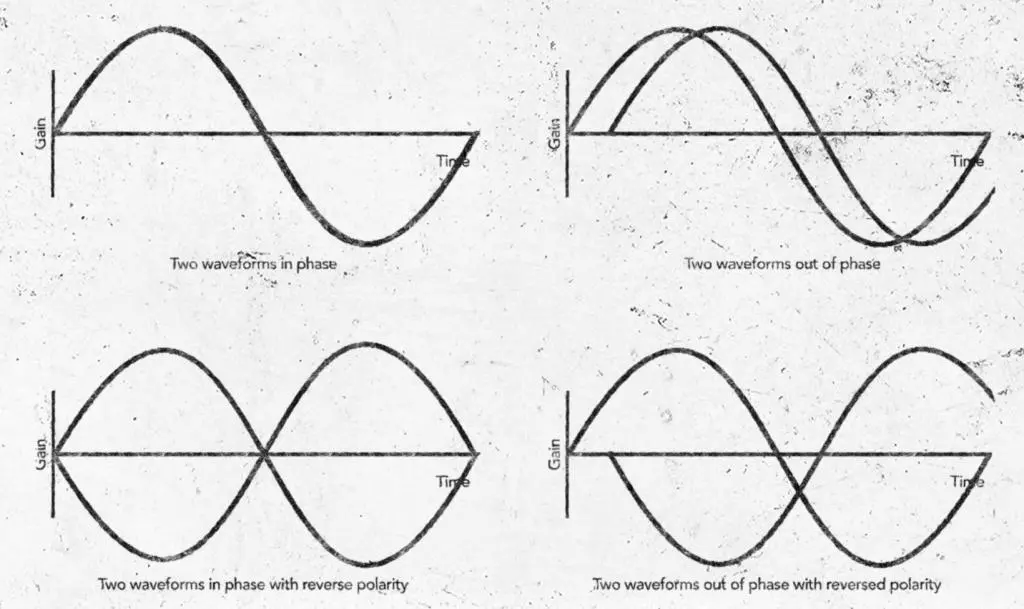More correctly termed absolute polarity, absolute phase describes a situation in which the phase remains constant throughout a signal path compared to a reference. In real situations, absolute phase means that the + and – polarity of a system are maintained from beginning to end.

For example, the leading edge of a sound wave usually causes a positive voltage in a microphone, and this voltage remains positive through all the connections and components in the audio system until it reaches the loudspeaker, where it produces a positive (forward) motion in the speaker diaphragm. Some audio engineers or sound live engineers states that absolute phase is essential for the best sound quality.
Table of Contents
What is Absolute Phase?
Everyone who works in the field of music production or audio engineering strives for the reproduction of sound to be as precise as possible. To accomplish this requires paying particular attention to each link in the audio chain, beginning with the source and ending with the listener. Absolute phase is one of the most important factors in reaching this level of accuracy.
To have a grasp on the concept of absolute phase, we must first get familiar with the fundamentals of capturing and reproducing sound. A device that is capable of converting sound waves into an electrical signal is known as a microphone. When sound waves reach the diaphragm of a microphone, they cause the diaphragm to vibrate, which allows the microphone to pick up the sound. Because of this vibration, an electrical signal is produced, which is then transferred to the audio system.
In most cases, a positive voltage will be produced at the output of a microphone after a positive pressure was applied to the diaphragm of the microphone. This aspect of the signal is referred to as its polarity. It is essential to keep in mind that not all microphones function in the same manner, and it is possible for some of them to produce an inverted signal under some circumstances.
After being processed by the audio system, the signal that was picked up by the microphone is subsequently played back by the speakers. The signal will generate a positive voltage at the speaker terminal if the polarity of the signal is preserved correctly all the way along the signal path. Because of this, the speaker is forced to move forward, which results in the generation of a positive pressure wave at the listening location. Absolute phase is the term used to describe the situation in which the speaker produces sound waves that have the same polarity as the sound waves produced by the original source.
Why Absolute Phase is Important?
The maintaining of absolute phase is one of the most important steps toward achieving correct sound reproduction. The sound waves are perceived as being more natural and detailed when the loudspeaker precisely reproduces the original polarity of the source sound in phase. This results in the sound waves being reproduced. This is of the highest concern for applications that require careful listening, such as recording and producing music, in which even the smallest of details can have a significant impact.
The vast majority of today’s audio equipment, thankfully, is built to keep absolute phase. This indicates that if you have an audio system that was designed correctly, the loudspeaker will faithfully duplicate the original polarity of the source sound while keeping the phase correct when it is played for listening.

FAQs on “Understanding Absolute Phase: What It Is and Why It Matters”
Understanding the concept of Absolute Phase can be complex, as there are numerous details and aspects to consider. Many questions may arise regarding this subject, but some answers can be found in the following section. If any additional questions come up, we will strive to update this article on Absolute Phase promptly.
What is Phase?
Waveforms in audio are cyclic, meaning that they have regular repetitions or cycles. The amount of time that has elapsed from the beginning of a waveform’s cycle is referred to as its phase. The degrees are the standard unit of measurement for phase, and one full cycle is equal to 360 degrees.
What is Polarity?
Polarity is a term used in the field of electronics to describe the relationship between two points that have opposing electric potentials, with one point having a positive electric potential and the other having a negative electric potential. It is important to clarify that polarity is not the same as phase, which refers to a relationship that is based on time.
Although engineers, consoles, and preamps may refer to the switch as a “phase” switch, in reality, it is a switch that inverts the polarity of the signal.
When interfacing electronic equipment, especially speakers, it is critical to ensure that absolute polarity is maintained at all times. In the event that this step is skipped, the sound quality may suffer as a result of one cone moving in while the other moves out of the speaker. Several designers believe that maintaining perfect polarity over the entirety of a signal channel is vital.
What does Out of Phase mean?
When two different waveforms are combined, it can create problems if the waves are “out of phase” with each other or if there is a delay between them. It is possible that this will cause some cancellation in the final audio, which will produce a “hollow” sound. The waveforms that are being cancelled, as well as the degree of phase difference between them, will determine the magnitude of the cancellation and the frequencies at which it will take place. Waveforms that are identical yet 180 degrees out of phase with one another cancel each other out totally.
What is Absolute vs Relative Phase?
The phase angle of a signal in relation to a reference signal, which is commonly a sine wave with a frequency and phase that is known, is referred to as its absolute phase. It is a measurement that determines where the timing of the signal falls in relation to the timing of the reference signal, and it is typically given in degrees or radians.
On the other hand, relative phase refers to the phase difference between two signals without reference to a predetermined phase angle. This is in contrast to absolute phase, which refers to the phase difference between two signals. In addition to being stated in degrees or radians, it is a measurement of the amount of time that has passed since the two signals were sent.
Is Polarity a Phase?
It’s important to keep the concepts of “phase” and “polarity” separate from one another. The terms “phase” and “polarity” describe changes to an audio system, with “phase” referring to a shift in time relative to a reference point and “polarity” indicating a switch in the positive and negative connections.
Can humans hear absolute phase?
Audio experts and scientists disagree on whether or not humans are capable of perceiving absolute phase in sound. While humans may not be able to sense exact phase, the quality of sound in some settings, such as when there are room reflections, may be affected by the phase relationship between different audio streams. Although some may argue that these impacts are negligible and hard to notice, others might disagree. While the idea of absolute phase is crucial in the field of audio engineering, it is generally agreed that it plays a relatively minor role in how humans perceive sound.

